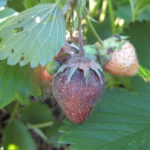Got mold?
Gray mold, caused by the fungus Botrytis cinerea and many other cryptic Botrytis spp., is one of the most important disease of strawberry, along with many other plants. To say this fungus is ubiquitous might be understating it!
Although its damage (and name) is recognized when fruit become infected, either pre- or postharvest, the fungus first establishes itself on damaged, dying (necrotic) parts of the plant; dying petals are particularly susceptible to infection. In this way, the fungus infects developing green fruit (directly) or remains dormant in the fruit until the strawberry ripens. Once established in the plant, Botrytis spp. can spread into fruit, leaves, petioles and crowns, causing botrytis blight.
Symptoms
On green fruit, firm brown spots can appear. On ripe fruit, light brown spots are formed, which remain firm. Spots usually begin at the cap end, but can also start at the point where an infected berry touches a healthy berry, or leaf. Leaf infection can begin as spots, or by contact with infected fruit. Spots can expand to blight leaves and work their way into the crown, causing blight. Frost or freeze damaged crowns, which happened across Indiana, are particularly susceptible to botrytis infection. Affected areas become covered by a powdery gray fungal growth, and thousands to millions of gray spores are produced during wet or foggy weather.
Epidemiology
Botrytis is favored by cool (59° to 75° F), wet weather and overcast conditions. The prodigious number of spores easily spread in wind, rain and via animals, including the human kind. Spores that land on fruit during harvest cause postharvest storage rots, especially when fruit is wet.
In high humidity, berries can be covered with cottony white fungal growth. Infected berries can become mummified, that is they retain their structure, become leathery, but are entirely rotted. This fungus can produce overwintering fungus balls, called sclerotia, that allows the fungus to persist in plantings.
Prevention
When planting strawberries, select a well-drained site, and space plants widely to facilitate air flow and allow leaves to dry. If irrigating, use drip lines and avoid overhead irrigation—wet foliage and fruit ‘leak’ providing botrytis a foothold to begin infection. Weed control is essential as they reduce air flow in plantings and can serve as reservoirs of spores (inoculum). Avoid excessive nitrogen application and overly lush growth which reduces a plant’s ability to defend itself from infection. Some varieties are less susceptible (and usually have tougher berries), but none are completely resistant. Varieties with very dense growth and more upright canopies are more susceptible to Botrytis. Fruit should be harvested when ripe and not allowed to rot in fields to prevent spore buildup.
Chemical Control
In addition to the Midwest Fruit Pest Spray Guide
https://ag.purdue.edu/hla/Hort/Documents/ID-465.pdf
the 2020 Southeast Regional Strawberry Integrated Pest Management Guide For Plasticulture Production has excellent information for fungicide application.
https://smallfruits.org/files/2020/02/2020-Strawberry-IPM-Guide.pdf.
Other points to remember:
- Limit the number of times fungicides with the same FRAC code are applied each season.
- Tank-mix protectant, FRAC M ( captan, thiram) when resistance is an issue, and even if it isn’t. Studies in Florida found improved (synergistic) disease control when using SDHI fungicides (FRAC 7) tank mixed with either thiram or captan for botrytis control (Amiri et al. 2018).
Amiri et al. 2018. The importance of selecting appropriate rotation and tank-mix partners for novel SDHIs to enhance Botrytis Fruit Rot control in strawberry. Plant Dis 103: 729-736
- Figure 1. Freeze damaged strawberry flowers. Photo by Janna Beckerman.
- Figure 2. Botrytis fruit rot. Photo by Janna Beckerman.

